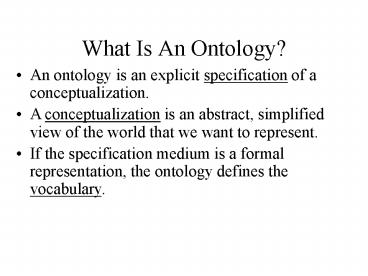What Is An Ontology - PowerPoint PPT Presentation
1 / 28
Title: What Is An Ontology
1
What Is An Ontology?
- An ontology is an explicit specification of a
conceptualization. - A conceptualization is an abstract, simplified
view of the world that we want to represent. - If the specification medium is a formal
representation, the ontology defines the
vocabulary.
2
What Isnt An Ontology?
- A database or program
- because they share internal formats only it is
not global - A table of contents
- Because it is not a formal representation of the
concepts - A terminology (aka controlled vocabulary)
- Because it is a set of terms without a formal
structure of how they relate
3
Ontology As Language
- The ontology becomes the language of the domain
it describes - The language syntax semantics
- While that language must be understood by
computers human readability counts
4
The History of Ontologies from a Biological
Perspective continued
- Biological community in general was slow to see
the value - Late 90s database providers in particlar began
to work together the gene ontology (GO) being a
major product of this effort - Now ontologies are the rage and warrant their own
session at Bioinformatics meetings and are taken
seriously by the biological community
5
Example from mmCIF
Syntax
Semantics
Semantics - The meaning of a string in some
language, as opposed to syntax which describes
the words and how they may be combined
independent of their meaning
6
Ontology as Contract
- Purposes of Ontologies
- data exchange
- unification/translation
- calling knowledge services
- representing theories
- human communication
- Parties to the contract
- programmers
- data admins
- programmers, netbots
- scientists
- collaborators
7
The Gene Ontology (GO) Specifically
8
References
- GO Itself - Creating the Gene Ontology Resource
Design and Implementation Genome Research (2001)
111425-1433 - The GO Website - http//www.geneontology.org
- Application of GO
- The Gene Ontology Annotation (GOA) project
implementation of GO in SWISS-PROT, TrEMBL, and
InterPro Genome Res. 2003 Apr13(4)662-72. Epub
2003 Mar 12
9
Brief History
- Started by Saccharomyces Genome Database,FlyBase
and the Mouse Genome Database - Grown to a consortium of members (see here)
10
Roles of the GO Consortium
- Write and maintain the ontologies themselves
- Associate the ontologies to genes in the
respective databases of members - Provide tools to facilitate the development and
maintenance of ontologies
11
Gene Ontology (GO)
http//www.geneontology.org/
- Three levels of annotation
- Molecular function - what a gene product does at
the biochemical level - Biological process - a broad biological
perspective not currently a pathway (no
dynamics or dependencies) - Cellular component - location within cellular
structures (eg Golgi apparatus) and
macromolecular complexes (ribosome)
12
GO Goals
From Genome Res 2001 Aug11(8)1425-33 pdf
13
Structure of GO-Directed Acyclic Graph (DAG)
Example from molecular function
Protein tyrosine kinase
Transmembrane receptor
Parent
Is_a
Is_a
Child
Transmembrane receptor tyrosine protein kinase
14
Structure of GO-Directed Acyclic Graph
(DAG)Relationship of Child to Parent
Is_a represents an instance of
Part_of
A mitotic chromosone is_a instance of a
chromosome A telomere is part_of a chromosome
15
Example - Molecular Function
16
Example - Biological Process
17
Example - Cellular Location
18
Example - Search
19
Some Issues Levels of Granularity Species
Specificity
- Chitin metabolism is part of cuticle synthesis in
fly - Chitin metabolism is part of cell wall
organization in yeast
20
Some Issues
- GO is dynamic parent child relationships can
change - When does a process begin and end?
- Is_a and part_of not always clear is actin
cytoskeleton is_a cytoskeleton or part_of
cytoskeleton - A community effort
21
Relationship to Gene Products
- A gene product is a protein or functional RNA
- A gene product may have more than one function
and therefore be related to multiple GO terms - The name of a gene product may only reflect one
of its functions
22
GO is Really 3 Independent Ontologies
- Annotation of a gene product by one ontology is
independent of its annotation by another ontology - Example Products of the MDH1 MDH2 and MDH3 genes
are all isoforms of malate dehydrogenanse in
yeast with the same function, but localize to
different cellular locations and are involved in
different biochemical processes
23
Evidence Codes
- The evidence for assigning a gene product to a GO
term has a controlled vocabulary see
http//www.geneontology.org/doc/GO.evidence.html
24
Research Applications of GO
25
Research Applications of GO
Research Applications of GO
26
Research Applications of GO
27
Research Applications of GO
28
Use of GO within the PDBhttp//pdbbeta.rcsb.org































